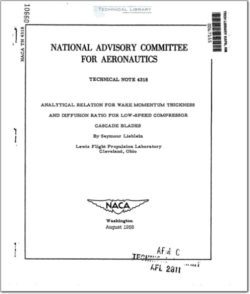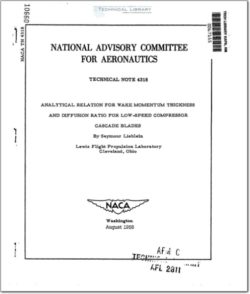NACA-TN-4318

- Version
- 207 Downloads
- 1.14 MB File Size
- 1 File Count
- December 4, 2015 Create Date
- December 4, 2015 Last Updated
National Advisory Committee for Aeronautics, Technical Notes - Analytical Reaction for Wake Momentum Thickness and Diffusion Ratio for Low Speed Compressor Cascade Blades

A simple equation relating wake momentum thickness and suction-
surface diffusion ratio (ratio of maximum surface velocity to outlet ve-
locity) of conventional low-speed cascade blades is derived from simpli-
fied boundary-layer theory'in conJunction with several empirical con-
stants. An analytical relation is thus obtained that describes the ex-
perimental correlations between momentum thickness and diffusion ratio
reported previously.
Inasmuch as the variation of wake momentum thickness with diffusion
ratio is shown to depend on the magnitude of the friction coefficient
and the type of boundary-layer flow, an insight is gained into the qual-
itative effects of such factors as blade-chord Reynolds nuMber, surface
roughness, transition location, and extent of local laminar separation.
Illustrative calculations show that a wide range of values of allowable
diffusion ratio (value above which the wake thickness becomes excessive)
can be obtained for different boundary—layer histories. These results
indicate that blades should be designed for low friction coefficient
(high Reynolds number and low relative surface roughness) and minimum
laminar flow (high Reynolds number and high free-stream turbulence) if
maximum allowable values of suction-surface diffusion ratio are desired.
The aerodynamic performance of compressor cascade blades is largely
determined by the growth and separation of the boundary layers on the
blade surfaces. In general, the surface boundary-layer development is a
function of many factors such as the surface velocity distribution, the
local skin-friction coefficient, and the location and nature of the tran-
sition from laminar to turbulent boundary—layer flow. These latter fac-
tors are generally'related to the design parameters of blade-chord Reyn-
olds number, free-stream turbulence level, and'blade surface finish.
A simple equation relating wake momentum thickness and suction-
surface diffusion ratio (ratio of maximum surface velocity to outlet ve-
locity) of conventional low-speed cascade blades is derived from simpli-
fied boundary-layer theory'in conJunction with several empirical con-
stants. An analytical relation is thus obtained that describes the ex-
perimental correlations between momentum thickness and diffusion ratio
reported previously.
Inasmuch as the variation of wake momentum thickness with diffusion
ratio is shown to depend on the magnitude of the friction coefficient
and the type of boundary-layer flow, an insight is gained into the qual-
itative effects of such factors as blade-chord Reynolds nuMber, surface
roughness, transition location, and extent of local laminar separation.
Illustrative calculations show that a wide range of values of allowable
diffusion ratio (value above which the wake thickness becomes excessive)
can be obtained for different boundary—layer histories. These results
indicate that blades should be designed for low friction coefficient
(high Reynolds number and low relative surface roughness) and minimum
laminar flow (high Reynolds number and high free-stream turbulence) if
maximum allowable values of suction-surface diffusion ratio are desired.
| File | Action |
|---|---|
| naca-tn-4318.pdf | Download |

Comment On This Post